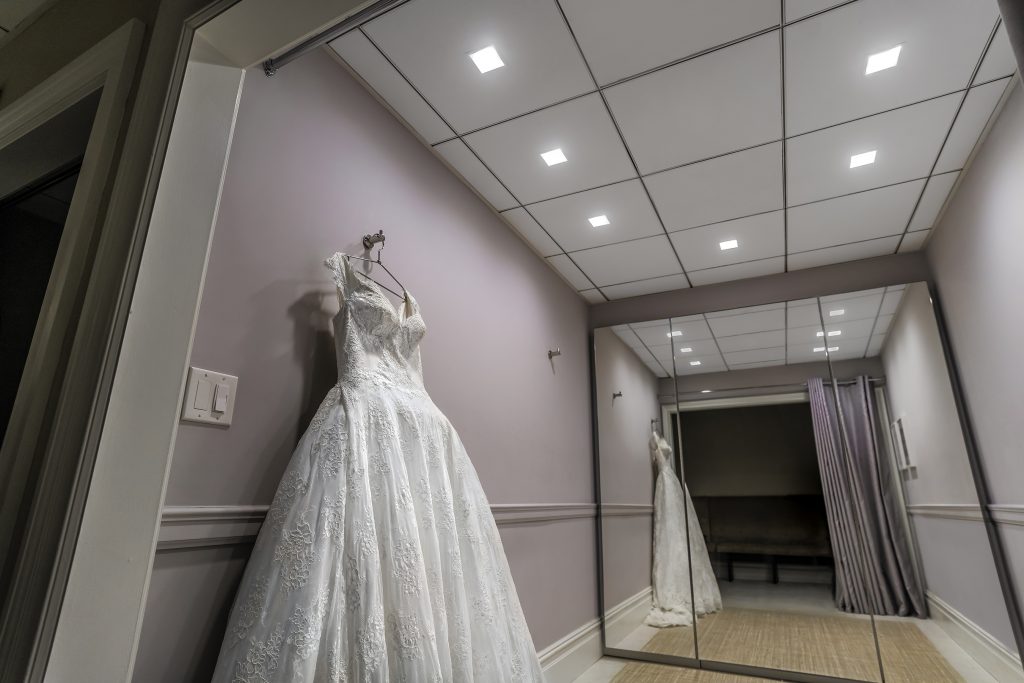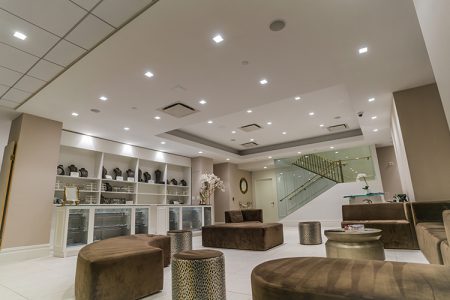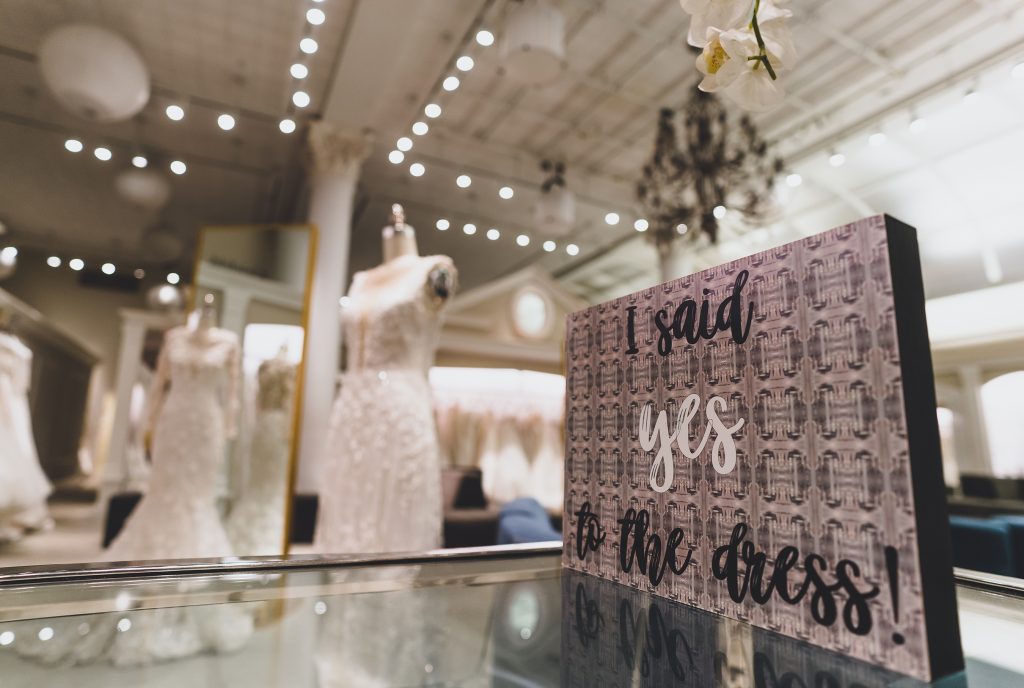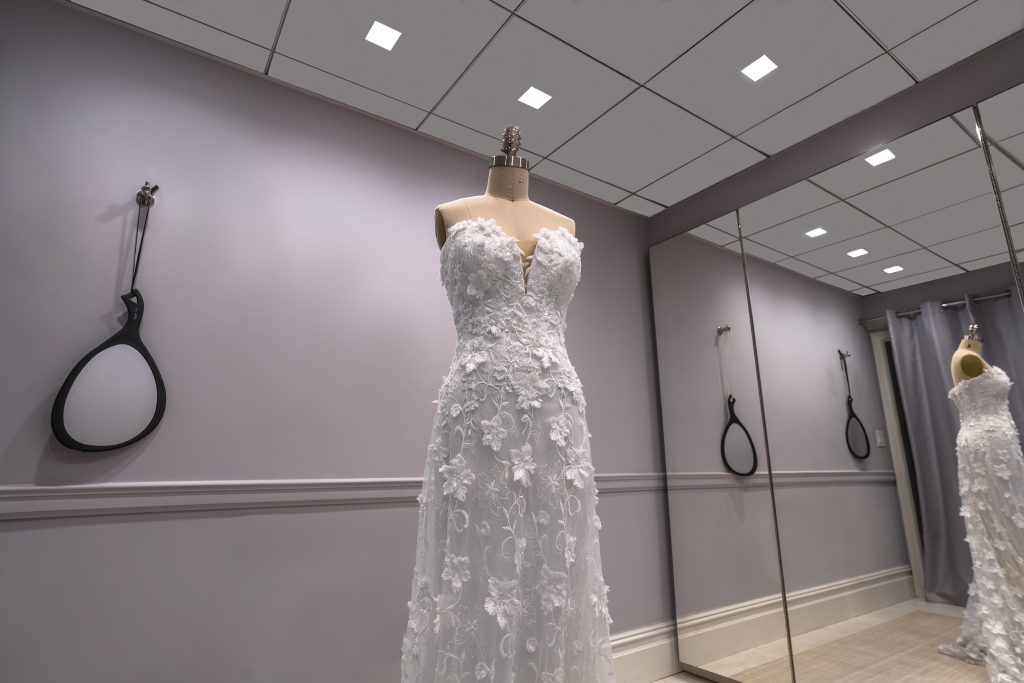
Articles
Lighting & HVAC
Case study: The retail impact of good lighting
May 1, 2020 | By Bill Plageman
An upgrade at New York’s Kleinfeld Bridal illustrates how the right lighting can make nearly any product pop—and wallets open
 Photo: Amerlux
Photo: Amerlux When it comes to a bride’s big day, anything less than picture-perfect colour is not acceptable.
Just ask Kleinfeld Bridal, the famous “Say Yes to The Dress” reality show venue and high-end retail store in New York City. The fashion retail icon’s aging lighting fixtures rendered colour poorly and created shadows, which caused customers to question their purchases.
To solve the problem, the bridal salon revitalized its fitting rooms with a new lighting design and modern fixtures that required fewer units to achieve better results.
The store’s original 8-foot-by-12-foot fitting rooms were cluttered with nine round downlights each, including standard downlights and eyeball-style lights. The legacy fixtures were not designed for LEDs, though they had been retrofitted with LEDs. Reworking the lighting plan and updating the fixtures created cleaner-looking, larger-feeling spaces without additional renovations.

Photo: Amerlux
Each of the 26 rooms, including the salon’s hallways and sitting areas, were upgraded with dim-to-warm downlights equipped with Class A LED chips, which rendered colour at a level far beyond what standard LEDs can deliver.
By reducing each room’s fixture count from nine to seven recessed downlights—one over the center of the mirror and three on each side—most shadows were eliminated by delivering better-quality light more evenly than the old luminaires could. In all, 185 downlights were installed.
The lensed-square lighting system chosen also coordinated with the existing square lighting in the nearby cashier area and stairwells.
Controls were also installed in each room, so the sales staff could present each dress in a variety of lighting scenarios to match whatever the bride would have on her wedding day.
To keep construction on schedule and on budget, the luminaires were delivered from the manufacturer within two weeks, as promised, minimizing installation time and impact on the store’s day-to-day business.
Good lighting is a must for retailers

Photo: Amerlux
When it comes to retail, Kleinfeld Bridal illustrates how—regardless of product or quality—good lighting is essential. Flat lighting makes any product look dull or unattractive. The right lighting can make nearly any product pop—and wallets open.
This is especially the case for brick-and-mortar retail, where quality lighting is often the difference-maker in motivating shoppers to buy. When retail customers see products under the right light, they can appreciate nuanced differences in colour shades—an experience buying online cannot provide. On a screen, colour and texture subtleties are oftentimes lost in the few photos showing the product.
Supermarkets know this well. Countless physical stores are now reconfiguring their layouts and lighting designs as part of a new strategy to keep customers, acquire new ones and remain relevant and profitable in the fast-changing grocery retail channel.
With online competition and nearby dollar stores capturing more of the dry-goods business, supermarkets are turning their attention away from shrinking centre aisles to their perimeters. This is where the “easily shoppable” departments are located and where produce, dairy, meats, seafood, hot and cold pre-made meals and other high-margin products are traditionally located, in open or closed-display cases, looking fresh and delicious—under the right light. That’s why many stores are upgrading their lighting systems.
But to install the right system, it’s key to first understand the system’s light source, and how colour quality is calculated.
What is colour quality?
Objects can look very different under different light sources. For instance, the surface and colour of a product under incandescent light is rendered very differently than under a fluorescent light.
That’s why there are measures of colour quality to properly compare and evaluate light sources. There are two commonly used colour quality measurements:
- Industry standard Colour Rendering Index (CRI), a 0-100-point scale that measures how accurately colours appear to the human eye, depending on the light source as compared to the sun. One hundred is a perfect score; zero is reflective of very poor colour rendering. Lights with a score of more than 90 are considered “high CRI” and deliver high-quality light.
- Illuminating Engineering Society’s up-and-coming TM-30.TM-30 is a newer colour scale growing in popularity. That’s because it measures colour rendering and saturation across 99 colours, rather than CRI’s eight colours. Still, CRI and TM-30 remain valid, go-to measures.
To better understand colour quality and its significance, consider how you look outside under cloudless, sunny skies, compared to how you look in the reflection of a common public bathroom mirror. The natural outdoor light is far more flattering than the restroom’s dim light. You simply look better, with natural skin tones.

Photo: Amerlux
That’s the game-changing impact of colour quality—attractiveness that leads to sales.
About 93 per cent of customers list visual factors as their top consideration when shopping, according to research from the Seoul International Colour Expo. What’s more, about 85 per cent of shoppers say colour accounts for more than half of the factors they consider when purchasing a product.
Installing better-quality lighting makes the colours and textures of products come to life with more vivid hues and dynamic patterns. It also revitalizes storefronts and displays with inspiring presentations and turns shops into must-see destinations seen in the best possible light.
Why LED lighting
More retailers are shifting from less efficient, older-generation lights such as fluorescent or halogen bulbs to modern, energy-efficient LED solutions, which best facilitate colour quality and matching.
They also deliver excellent light consistency, maximum flexibility, as well as significant energy savings and longevity. That’s because older sources of lighting like incandescent create light by heating a wire filament or exciting gases inside glass bulbs to create light. This heat fades colours and wilts fresh foods.
LED lights’ solid-state manufacturing contributes to their unparalleled durability, longevity, colour quality levels and flexibility for users—including the contractors who are installing them and the distributors selling them.
LEDs are unquestionably the retail lighting of the future for their ability to render quality colour, ease of installation and ease of maintenance. They produce light that creates attractive and compelling shopping and retail environments, stirs customers’ desires and spurs buying.
No other light source can beat or even match LED when it comes to rendering vivid, eye-catching colours across various products lines, display cases and shelves. It’s the type of lighting that guarantees products are being seen in the best light.
Bill Plageman is VP of marketing and product development for lighting company Amerlux.
This article originally appeared in the February 2020 issue of Electrical Business.
Print this page